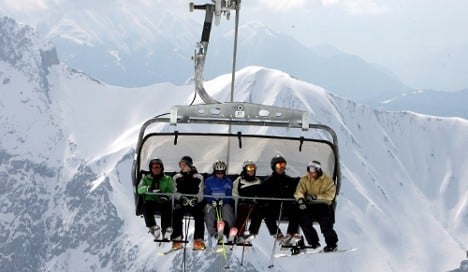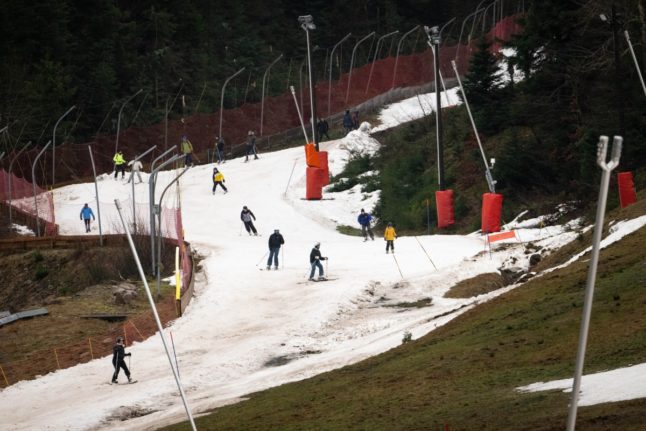Skiing in Germany is typically associated with the Alps in Bavaria. If you’re looking for the classic Alpine experience with the decadent Après ski lodge lounging culture in Germany, by all means take a trip to the Garmisch-Partenkirchen and swoosh down the famous Zugspitze. But there are also plenty of other downhill options sprinkled around the country. For something a little closer to home, take a gander at our tips for some alternative German ski destinations.
Many of these quirky ski areas don’t have the cushy high-speed lifts or opulent lodges typical to larger Alpine resorts, but this – along with cheaper tickets and smaller crowds – is part of their charm.
And those who don’t ski or snowboard can still enjoy the season. Many of these destinations offer other winter activities such as sledding, snow-shoeing, cross-country skiing or just a nice seat at the lodge to sample the local schnapps.
Click here for photos of ski areas highlighted in The Local’s ski guide!
The Rhön
You’ll find the Rhön Mountains snuggled between the states of Hesse, Bavaria and Thuringia. These low-elevation, dome-shaped mountains provide gentle slopes for beginners and not-so-extreme skiers. Dotted with imposing mediaeval structures, the scenic area was declared a UNESCO Biosphere Reserve in 1991 for its unique environment.
The Feuerberg area has the best-groomed pistes and claims to have the only chair lift in northern Bavaria. The area promises runs for all ability levels, as well as a ski school for beginners and several huts and lodges where ruddy-cheeked guests can warm up with typical fare like Germknödel, a doughy dumpling filled with plum jam and smothered in vanilla sauce.
Smaller resorts in the region include the Wasserkuppe, which features night skiing, a terrain park with a half-pipe for thrill-seekers, and a 600-metre, lift-served toboggan run for the little ones and the young at heart.
Other areas worth a look are the tiny Arnsberg, Bischofsheim, and Zuckerfeld resorts.
The Black Forest
Deep in southwestern Germany lies Baden’s fabled Black Forest region, which has some 200 ski lifts to deliver winter sports fans to the tops of more than 70 peaks above 1,000 metres.
The Liftverband Feldberg combines a total of 28 lifts from a network of mountains to form the region’s largest downhill resort atop Germany’s highest peak outside the Alps.
Those interested in combining a ski trip with a bit of city sightseeing should try Stollenbach, which is just a 25-minute car trip from the sunny and picturesque university town of Freiburg. The area bills itself as an affordable family resort with three lifts to serve visitors with novice to intermediate skill levels.
For those who want to venture deeper into the land where cuckoo clocks were invented, there are more than 20 other small resorts dotting the landscape. Favourites include Todtnau and Schauinslandbahn.
Go East!
Though it may come as a surprise to some, the former East German states of Saxony and Thuringia also have a handful of treats for skiers. Saxony has three areas along the Czech border, all within reasonable distance of Berlin, Dresden and Leipzig. Among the best is the 1,206-metre Fichtelberg, which was the highest peak in the now defunct communist German Democratic Republic (GDR). Part of the Ore Mountains, or Erzbegirge, the peak looms above the traditional resort town of Oberwiesenthal. The largest ski area in Saxony, it has six lifts, an aerial tram and ample accommodation.
Further south along the Czech border lie two small areas with four lifts each: Klingenthal, and Schöneck, both within the Erzgebirge/Vogtland Nature Park. Relax after a day on the slopes by checking out the museums devoted to the region’s tradition of making musical instruments and other handicrafts.
Meanwhile in the Thuringian Forest, which rests atop an ancient mountain range west of Erfurt, winter enthusiasts will find a group of diminutive slopes well-suited for beginners.
The Harz Mountains
The German state of Lower Saxony is home to the western half of the Harz Mountains, where many of the region’s ski areas are located. The highest peak in the state is the Wurmberg at 971 metres and is home to the largest ski area in the region. With three pommel lifts and a gondola the Braunlage resort has become a popular destination for northern Germans.
Northwest of there is Bocksberg-Hahnenklee with five ski runs of varying difficulty and two lifts. The resort emphasises its use of snow-making machines in the face of the warming climate, so don’t let a dry season put you off. Ski and snowboard lessons are also available for those looking to perfect their turns.
Sauerland
The hilly, wooded district of Sauerland in Germany’s western state of North Rhine-Westphalia offers a surprisingly rich selection of skiing options a mere 200 kilometres from Cologne.
With Six chairlifts and 12 pommel lifts the Winterberg is among the most popular destinations. There are 17 slopes of varying difficulty, as well as a ski school. The town is the winter sport centre of the state, featuring a one-of-a-kind combination bobsled, luge and skeleton track.
There is a cluster of other small ski areas near Winterberg. The largest is the gondola-served Willingen, which hosts World Cup ski jumping and promises snow thanks to a fleet of snow-making machines. The resort also has night skiing on several of its 25 pistes.
Baltic Bumps
The state of Schleswig-Holstein isn’t known for lofty peaks – or even small hills. But if the snow gods are feeling generous, the private owners of the Bungsberg ski area are able to open a tow-rope lift on their lonely 168-metre bump in the landscape. On these fortuitous days visitors can get a day pass priced around just €10 for the latitudinal novelty of hitting Germany’s most northerly ski slope. Keep an eye on the northern coast’s weather report for the singular chance to see ships floating on the Baltic Sea horizon while perched on skis – followed by a very short trip to the bottom.



 Please whitelist us to continue reading.
Please whitelist us to continue reading.